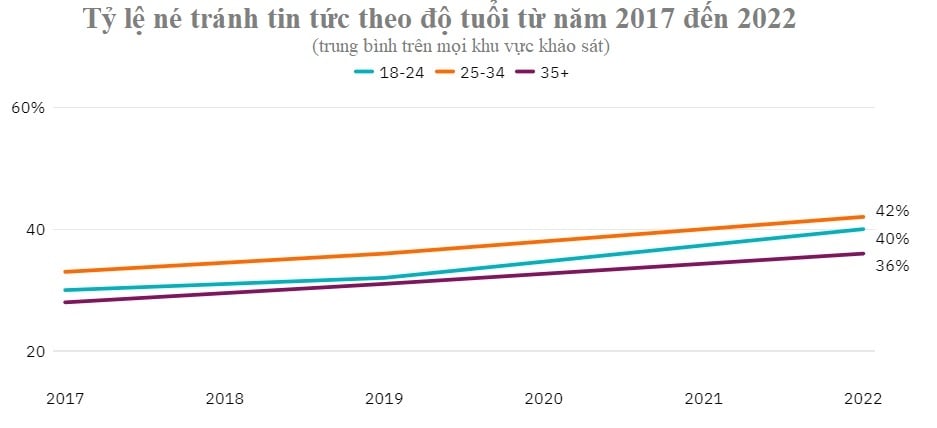Even with the role of enlightening society to good values, winning back young readers is also a noble mission for the press!
Sources of motivation from young people
As we know, the world press in general, and Vietnam in particular, is continuing to fall into crisis in all aspects, from economics , trust and especially the loss of readers of all ages. Most surveys, as well as our own awareness, indicate that readers are increasingly shunning traditional news. The loss of readers, especially young people, may not be due to the press itself, but to the rapid rise of social networks and technology platforms that have superior technology and even reprehensible "tricks" .
In other words, the world of journalism can be said to have been like the naive guy for a while, and lost too many things to others. But the time has come for the world of journalism to wake up and realize that it is time to regain what has been lost and especially fight for a more sustainable, not to mention brighter, future.

Research shows young people are willing to pay for news. Photo: Internet.
In the mission to win back readers, there are many audiences that the press needs to target, but it cannot be denied that young readers are the most important source for the press to turn the situation around, to turn defeat into victory. In terms of both its own existence and professional ethics, the press must win this battle.
First of all, a big and very real issue when it comes to attracting new readers in general, and young readers in particular, in the current difficult economic context of the press is whether young readers are willing to pay or contribute to use today's press products or not? Recent surveys around the world show a picture that is completely opposite to the often pessimistic thinking of everyone. In fact, young readers are willing to pay for news, from the Millennial generation to the Gen Z generation.
A survey of 6,000 readers ages 16 to 40 for the Media Insight Project, a collaboration between The Associated Press, the NORC Center for the Study of Journalism and the American Press Institute, found that overall, 60 percent of those under 40 have paid or donated to news in some way. And those who pay or donate to news are a majority in every age group they surveyed, including those at a very young age.
Specifically, 51% of Gen Z (ages 16 to 24) are willing to pay or donate for news, and that number rises to 63% of younger Millennials (ages 25 to 31) and 67% of older Millennials (ages 31 to 40). The numbers show the real potential for sustainable revenue if news organizations, whether traditional or start-up, can create content that young people find valuable.

Don't let the media world for young readers be just information floating on social platforms. Photo: GI
Obviously, that is a big motivation for the press. This is actually an understandable phenomenon when the environment and lifestyle in the technology era have helped the younger generations have the habit of spending money on services that they feel are necessary, such as paying for TV or paying for games.
Now or never?
That means, the press still has a future ahead if it goes in the right direction and does well to attract young readers to itself, otherwise disaster will happen. The big question now is how to attract young readers? First of all, it cannot be denied that the press needs to completely change radically to suit the current young readers in particular, and future generations in general. And to suit, first of all, the press needs to understand them.
Obviously, for the young generation today, journalism is no longer just articles printed on paper, news on TV or appearing monotonously on electronic interfaces, like the era of their fathers or brothers and sisters. For young people, news is also society. Simply, they have grown up with social platforms. Most of them themselves realize that receiving news is not sitting reading articles, but surfing the news, having fun and interacting, without even understanding what “news” really is or there is no longer any “idol” in the world of journalism. It is very different from the old days.

The traditional press world needs to re-engage the younger generation of readers from social networks and technology platforms. Photo: GI
To better understand young audiences’ relationship with news, the Reuters Institute of Journalism and strategy agency Craft conducted qualitative research with groups of 18-30 year olds in Brazil, the UK and the US in 2022. They drew some interesting conclusions. Young people see “news” as a very broad category, which can be divided into “narrow news” and “broad news” .
“Narrow news” is about mainstream, serious and macro information. Meanwhile, “broad news” is about lighter stories such as entertainment, fashion , sports, celebrities, culture… In particular, young people often avoid “narrow news” or “serious news” .
According to the survey, the level of news consumption among young people is as diverse as the number of young people. For example, there are people who like to watch the news for entertainment or out of civic duty to know what is happening. However, there are many who will feel a practical need to keep up with developments as they impact their daily lives, rather than out of pleasure or obligation. Young people in particular are very skeptical of most information, due to the influence of social networks.
Additionally, it’s a no-brainer that young people are “form-conscious.” Young people enjoy a variety of formats and ways of communicating information, and are drawn to information that is curated specifically for them – elements that social platforms like Facebook, YouTube, and TikTok have taken advantage of. Young readers often prefer to read a piece that includes text, video, audio, and of course still images.
Mainstream news organizations can’t please all young people, but the survey results clearly show that newspapers have a better chance of being chosen more often. They need to make the areas of information they cover more diverse and rich. In fact, even political reporting can be attractive to young readers, if it is designed for them.
Go to social networks to win back the youth
According to research, young people's news consumption and attitudes towards news are changing rapidly, showing a greater reliance on social media and a growing avoidance of mainstream news.
In a 2022 study by the Reuters Institute for Journalism and the University of Oxford, social media was increasingly replacing news websites as a primary source for young audiences overall, with 39% of young people (18-24 years old) across 12 countries citing social media as their primary source of news, compared to just 34% who preferred to go directly to a news website or app. This ratio may be even more skewed in some regions.
News avoidance rates among young readers are increasing. Young people are increasingly avoiding traditional news. According to the survey, about 40% of people under 35 often or sometimes avoid current news, compared with 36% of people 35 and older. Source: Reuters Institute of Journalism and Oxford University survey.  |
In fact, young readers are shifting their attention away from Facebook to more visual platforms like Instagram, TikTok and YouTube, which are increasingly popular for consuming “information” for young people. Use of TikTok for news has increased fivefold among 18-24 year olds across all markets in just three years, according to the study, from 3% in 2020 to 15% in 2022.
What makes these networks so appealing to some younger audiences? Surveys reveal that they are drawn to the informal, entertaining style of visual media platforms (and especially online video) – describing it as more personal and diverse than TV, as a resource for fast-changing events like the Russia-Ukraine conflict and other highly volatile events.
That is a picture that shows how great the challenge is for the world press if it wants to win back young readers from social platforms, especially in the current difficult context, when even finding new readers in general and winning back old readers is very difficult.
However, no matter how difficult it is, the world of journalism in general cannot ignore this task. First of all, as mentioned, young people are the most abundant source of readership for journalism. Then, the more noble mission is to help the majority of young readers stay away from the negative aspects of social networks and other social technology platforms.
Not an impossible mission
Journalism is actually just one part of society in its mission to help young people live a more authentic and healthy life, alongside other areas such as literature, art, education, and even economics and law (such as preventing the sale of floating goods on social networks or users being frequently scammed on social networks).
But the press will be an important part of this mission, because this is really like a "war of words" between traditional press and social networks, which are increasingly overwhelmed by nonsense, clickbait, even toxic and misleading information... due to their algorithms that prioritize virality. If the press does not do its job well and fails in this "war of words" , the information world of future generations will be a world of such floating information streams.
Just like any other field, journalism is not here to destroy or alienate social platforms, and cannot be caught up in their own spin, but to help its readers understand more and bring them back to true values.
In particular, as is widely recognized in the world, this mission requires the involvement of the authorities. Pressure is needed for social networks to become healthier, more serious and to comply with common values in the world of journalism and media, instead of being self-sufficient and even becoming an addiction for young people.
Obviously, the mission is difficult, but not impossible. Young people are the most fickle, and their easy entry into social networks is partly due to the neglect or backwardness of the press towards young people, as well as the "credulity" of the press towards technology platforms.
Obviously, regaining readers' attention is not beyond the ability of the press. What is important is the cooperation of everyone, from journalists, press organizations, policy makers... and social networks.
There will not be one or a few specific solutions, but fundamentally the world of journalism will have to change, the reality is changing dramatically, and must always aim at young people as the top audience that they need to conquer!
Tran Hoa
Source







![[Photo] Keep your warehouse safe in all situations](https://vphoto.vietnam.vn/thumb/1200x675/vietnam/resource/IMAGE/2025/10/1/3eb4eceafe68497989865e7faa4e4d0e)





























![[Photo] President of the Cuban National Assembly visits President Ho Chi Minh's Mausoleum](https://vphoto.vietnam.vn/thumb/1200x675/vietnam/resource/IMAGE/2025/10/1/39f1142310fc4dae9e3de4fcc9ac2ed0)




























































Comment (0)